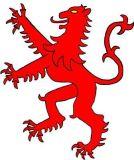 |
|
|
|
| Author |
Message |
Steve
Location: Drury South Auckland
|
 Posted: Thu Jun 10, 2010 12:36 pm Suspension harness for helmet Posted: Thu Jun 10, 2010 12:36 pm Suspension harness for helmet |
 |
|
Hi all
I bought a second hand helmet a few years ago. I have fixed it up and now turn to the inside.
so my problem is I'm more of a metalworker than leather. so does anyone have a pattern or tips for making the suspension harness for a helmet? also should I measure my head and add the thickness of some kind of padded cap?
Help would be appreciated! 
_________________
Hige sceal þe heardra, heorte þe cenre,
mod sceal þe mare, þe ure mægen lytlað.
[Thought must be the harder, heart be the keener,
mind must be the greater, while our strength lessens.]
Maldon poem |
|
|
 |
White Knight

Location: Orcland
|
 Posted: Sun Jun 20, 2010 10:50 pm Posted: Sun Jun 20, 2010 10:50 pm |
 |
|
A suspension lining consists of four or more triangular sections joined together at the top by a cord.
Adjust the cord to make the helmet fit your head.
Such a lining would fit several head sizes.
Each segment should be padded with wool.
A leather suspension harness with no padding is not suitable by itself. It just won't offer enough cushioning and may not be acceptable for head blow combat.
A leather band is rivetted to the inside of the helmet and the lining is stitched on to the lower edge of this leather band.
I believe the leather band is used because rivets may eventually pull through the linen lining.
The basic pattern would look like 4 triangles on the side of a narrow rectangle.
The "rectangle" should be the same length as the leather band.
Sorry can't post any pictures as I wasn't able to transfer them to my new computor. But hopefully you get the idea.
If made properly there should be a gap of an inch or more between the top of the lining and the top of the helmet on the inside.
The size of the gap will depend upon the style of your helmet.
The gap is for your protection but if you were to have no gap (not recommended) then you would need to making the lining thicker.
Suspension linings appear to have only been used historically for large medieval helmets e.g. jousting helms, great bascinets, etc.
Other helmet types e.g. kettle helms and small bascinets were used in conjunction with a padded coif.
If you are making this for a viking helm the basic shape would be cone-shaped once the cord is pulled together.
If you are making it for a great helm you may want to extend the back of the neck to provide more comfort.
One other tip: Attach a chin strap before you sew the lining on to the leather band.
Hope that helps.
_________________
Living History. Choose to be part of it. |
|
|
 |
Victorius
Location: IMPERIVM ROMANA: The Roman club with a Living History focus.New Roman Club
|
|
|
 |
Nathan
|
 Posted: Thu Jun 24, 2010 7:56 pm Posted: Thu Jun 24, 2010 7:56 pm |
 |
|
That style, made with quilted material (linen and wool) is about as good, and as period, as you get.
Origanial example:
| Description: |
|
| Filesize: |
73.12 KB |
| Viewed: |
29165 Time(s) |

|
|
|
|
 |
Steve
Location: Drury South Auckland
|
 Posted: Tue Jun 29, 2010 8:38 pm Posted: Tue Jun 29, 2010 8:38 pm |
 |
|
Thanks that helps heaps!  so leather is to fragile? or just not enough shock absorption? would it work wearing a coif or padded headpiece as well? so leather is to fragile? or just not enough shock absorption? would it work wearing a coif or padded headpiece as well?
_________________
Hige sceal þe heardra, heorte þe cenre,
mod sceal þe mare, þe ure mægen lytlað.
[Thought must be the harder, heart be the keener,
mind must be the greater, while our strength lessens.]
Maldon poem |
|
|
 |
Nathan
|
 Posted: Wed Jun 30, 2010 8:26 am Posted: Wed Jun 30, 2010 8:26 am |
 |
|
Leather doesnt give enough to give you maximum protection, quilted fabrics such as linen and wool do, as far as I've been informed. Combined with a padded arming cap is how I'll be doing mine from now on.
have a look with the serch function on
www.armourarchive.org
www.myarmoury.com
|
|
|
 |
|
|
 Please read the terms of use
Please read the terms of use
 Contact the Site Admin
Contact the Site Admin


